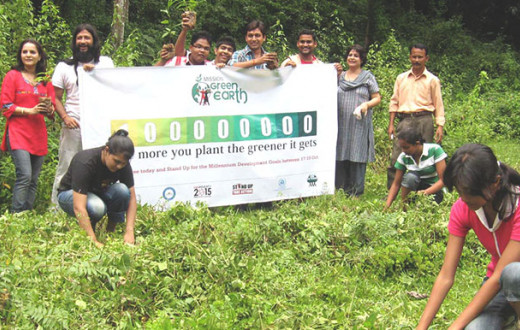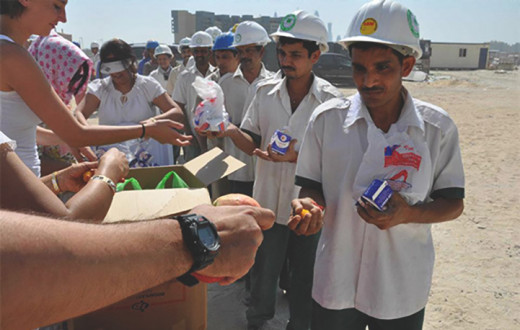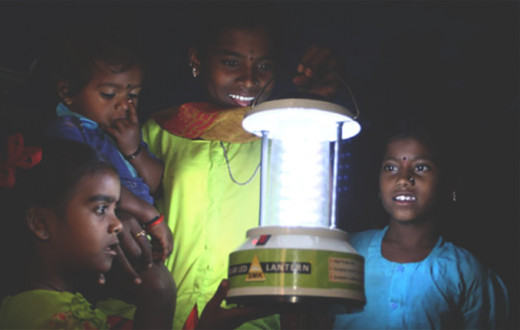“We used to go in the slums, sit on the streets and do satsang, children and some people used to gather to listen. Then one day they told us that they had a room which we could use for our programs, that’s how it all began.”
There are 30 slums in Bangalore that have been adopted under the ‘Divine Karnataka Project,’ a YLTP (Youth Leadership Training Program) initiative. The YLTP teachers and ‘Yuvacharyas’ spread across these slums train the youth in computers, spoken English and soft skills, further, giving them job orientations and preparing them for employment. Put in yoga, meditation and ‘Sudarshan Kriya,’ these youth from the slums are being empowered, and the number is only increasing.
I had a privilege to visit one of these slums. It was a warm and sunny noon; I got down at Majestic and took another bus to Okhlipuram, where I was to meet Rukmini ji, a YLTP teacher and a ‘seva’ warrior; one of the three women who started the work in the slums of Bangalore. Standing across the street in a pink kurta and white pajamas, salt pepper hair matured with service, she greets me with a smile. I sit behind on her scooter, and she takes me to Srirampuram.
Dayananda Nagar, in Srirampuram didn’t come across as a slum in the literal sense. Closely crowded two to three storied buildings, narrow lanes cutting across shops and kiosks, children running around barefoot, it looked more like a concrete village. We stopped and parked in front of a three storied building, climbed up a narrow staircase to the second floor and entered the center. A group of over 20 people were sitting in the first room, listening attentively to Radha, who was teaching them English. As we entered they all greeted us with a Jai Gurudev! Rukmini ji took me into the second room inside. Over 20 computers were sitting on the table. “We teach computers to them too,” said Rukmini ji watching me looking around, “we have two batches, one in the morning and one in the evening.”
It all began in March 2004, when Dr Hema the visionary, Rukmini ji the ‘seva’ warrior, accompanied by Nagrajja, got together and decided to ‘penetrate the slums and make a difference,’ this was their vision. They didn’t know what to do and how exactly to go about. “We used to go to the slums, sit on the streets and do satsang,” recalls Rukmini ji. “Then we chose one area, Nagamanagar, three km from here. We were given a room which they said we could use for free. We started with having a day of craft and a day of spoken English classes a week for school children. Dr Hema and I would teach, now and then some volunteers would join us. We used to teach the kids every week. Gradually we formed such centers in four other places and hired people to teach. Two to four hours of tuition in four to five places around the area, that’s how we started. The initiative started to spread and take shape, and then the ‘Divine Karnataka Project’ (DKP) happened, we don’t even know how. Now we are working in 30 slums all over Bangalore, and we have ten such computer centers. Whoever comes for these classes have to take the Part 1 course,” smiles Rukmini ji.
The astounding fact is that even after being approached, the Government was not too keen on funding this project. If none of the participants are charged, how did they generate funds and how is it sustained? “We collected from friends and we pitched in too,” shares Rukmini ji. “We don’t know how to market, we just have been working. But things are happening now. Now we have the Art of Living centers that raise funds for us. The computer center here is funded by Reliance.”
“We also work with around 30 government schools across all the slums,” shares Rukmini ji, briefing me about the work they do in these schools. “We don’t really focus on academics, we teach them Bal Chetna Shibir, YES and then the ART Excel. Every day the children meditate to ‘Ram Dhyaan.’ In government schools it is mandatory that all the kids be promoted, so when you see a 6th or a 7th grade student, they can’t identify alphabets or form words or sentences. This was a problem. So we took a screening test and graded the kids into two groups; ones who couldn’t read at all, and the ones who couldn’t form words and sentences. Everyday our ‘Yuvacharyas’ taught them for 40 minutes. Before the academic year ended, we took another screening, and the result was positive, we saw a profound change. Another area that we focused on, were the parents. The schools would never have a parent- teacher meet, even the principal would discourage it. So we sent our ‘Yuvacharyas’ to the homes of the children to invite the parents in person, and the response has been amazing,” shares Rukmini ji.
Rukmini ji and her team are working with the women of the slums too. “It’s difficult to get the women under one roof, here in the slums the women just don’t come out,” exclaims Rukmini ji. “We want to take courses for them, but it is not that easy. It’s not like the villages, where it is much simpler to reach women and gather them and teach and work with them. But now, we have more than 30 SHGs in the slums here. All of them have opened bank accounts, and one of the groups also received their first loan from the bank. We also had an annual day mid February, where 150 women gathered and participated. The women after the annual day, have opened up, they feel energized and some of them have also done the Part 1course,” smiles Rukmini ji.
It has nearly been a decade of rigorous leg work, after which the foundation has been laid which gave birth to the ‘Divine Karnataka Project.’ Rukmini ji, Dr Hema, Nagrajja, the ‘Yuvacharyas’ and all the YLTP volunteers have been working endlessly, in the insides of Bangalore. Without any hype or recognition, they continue to work towards building an ideal society. When asked, what her vision is, Rukmini ji replies almost nonchalantly, “Personally, I’m not the visionary, I only love to work and I will continue to.”
Please write to us at webteam.india@artofliving.org with your comments and ideas








